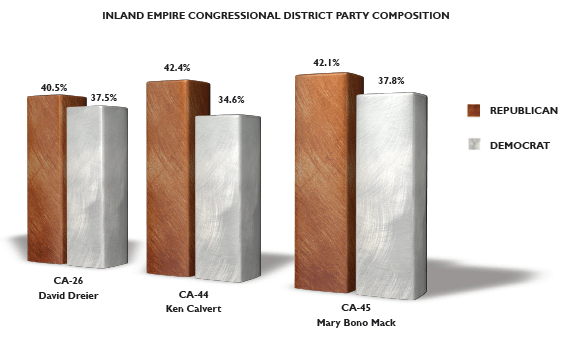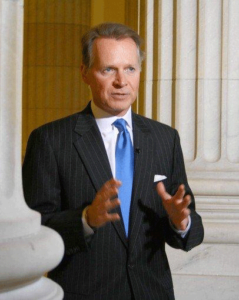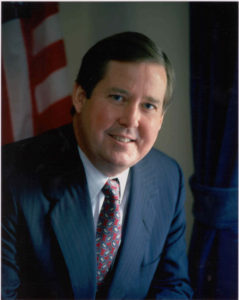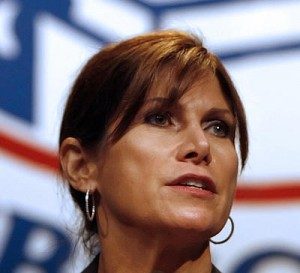 2010 should be a fairly entertaining political year in California. Indeed, on top of the reality of the Census and the possibility of a Constitutional Convention comes the drama of some potentially close Congressional races, three of which will be contested within the Inland Empire: David Dreier’s (CA-26), Ken Calvert’s (CA-44), and Mary Bono Mack’s (CA-45). Part of the reason that all three of these races are considered competitive is the demographic change and population shift that has occurred in the Inland Empire over the last several years.
2010 should be a fairly entertaining political year in California. Indeed, on top of the reality of the Census and the possibility of a Constitutional Convention comes the drama of some potentially close Congressional races, three of which will be contested within the Inland Empire: David Dreier’s (CA-26), Ken Calvert’s (CA-44), and Mary Bono Mack’s (CA-45). Part of the reason that all three of these races are considered competitive is the demographic change and population shift that has occurred in the Inland Empire over the last several years.
While none of these districts are yet clear takeover opportunities, some could develop into very competitive races. The races were deemed potentially competitive based on three factors: (1) the race was competitive in 2008; (2) the incumbent won the last election by a narrow margin; or (3) either the Democrats or Republicans have targeted the race.
Before looking at individual races, it is important to consider briefly the overall environment in California going into 2010. In 2008, Barack Obama did very well in California, even in traditionally Republican districts. Having Obama at the top of the ticket clearly helped Democrats further down the ballot and made some Republican incumbents do worse than they otherwise would have done. In 2010, Obama will not be at the top of the ballot. Instead, the election will feature the Governor’s race and the U.S. Senate race. With Gavin Newsom’s departure from the race, 71-year-old Jerry Brown will likely be the Democratic gubernatorial nominee, and incumbent Democratic Senator Barbara Boxer will be the nominee for Senate. While both Brown and Boxer may run strong campaigns, neither will create enough excitement to help Democratic congressional candidates down the ballot in the way that Barack Obama did in 2008. Republican incumbents who had close elections in 2008 because of Obama will likely face a more favorable climate in 2010.
CA-26 David Dreier (R)
 As the Ranking Member on the Rules Committee, David Dreier is one of the most important Republicans in the House of Representatives. He is currently serving his 15th term in Congress and plans to run for re-election in 2010. Dreier’s 26th district was designed to be safely Republican. It runs along the 210 Freeway corridor, extending from Los Angeles County into the Inland Empire. It includes part or all of the foothill cities of Sierra Madre, San Gabriel, Pasadena, Monrovia, Glendora, Walnut, Covina, San Dimas, La Verne, Claremont, Montclair, Upland, and Rancho Cucamonga, as well as portions of the Angeles National Forest. The district has grown by about 50,000 people since 2000 and currently has a total population of about 688,700, according to the Census Bureau’s 2008 American Community Survey. The district’s population is now approximately 64.6% white and 30.2% Hispanic. The district has 40.5% registered Republicans and 35.7% registered Democrats.
As the Ranking Member on the Rules Committee, David Dreier is one of the most important Republicans in the House of Representatives. He is currently serving his 15th term in Congress and plans to run for re-election in 2010. Dreier’s 26th district was designed to be safely Republican. It runs along the 210 Freeway corridor, extending from Los Angeles County into the Inland Empire. It includes part or all of the foothill cities of Sierra Madre, San Gabriel, Pasadena, Monrovia, Glendora, Walnut, Covina, San Dimas, La Verne, Claremont, Montclair, Upland, and Rancho Cucamonga, as well as portions of the Angeles National Forest. The district has grown by about 50,000 people since 2000 and currently has a total population of about 688,700, according to the Census Bureau’s 2008 American Community Survey. The district’s population is now approximately 64.6% white and 30.2% Hispanic. The district has 40.5% registered Republicans and 35.7% registered Democrats.
Although the 26th district was designed to protect Dreier, it has not been completely safe. Dreier survived a scare in 2004, when he was targeted by conservative talk radio hosts for his positions on immigration. That year, he narrowly defeated underfunded Democratic challenger Cynthia Matthews by a vote of 54% to 43%, one of the closest congressional races in the state. In 2008, Dreier defeated Democratic businessman Russ Warner by over 10%, but President Obama won the district’s with 51% of the vote.
The Democratic Congressional Campaign Committee (DCCC) viewed this seat as a target in 2008 and may do so again in 2010. Dreier has formidable financial resources ($940,000 cash on hand as of the third quarter of 2009). Warner, his 2008 opponent, has announced he will run again in 2010, but raised roughly only $40,000 in the third quarter of 2009, leaving him with $95,000 cash on hand. Dreier is potentially vulnerable against a strong Democratic candidate, but unless Warner runs a better campaign than in 2008, or a stronger Democratic challenger enters the race, Dreier will likely win election to his 16th term in 2010.
CA-44 Ken Calvert (R)
 Nine-term Rep. Ken Calvert had a surprisingly close race in 2008. He won reelection by only 2% against Democratic challenger Bill Hedrick, an underfunded public school teacher. Hedrick is currently in his 5th term as the President of the Corona-Norco Board of Education. Calvert had won this district comfortably in past elections, but the district has been trending Democratic in recent years. While President Bush won the district’s vote in 2004, President Obama narrowly won it in 2008 with 50% of the vote. Democrats have been gaining ground in voter registration in the district; the number of registered Democrats is up by around 2.5% since 2006 while the number of registered Republicans is down by around 4.5%. Currently the district is approximately 42.4% Republican and 34.6% Democrat. The 44th district contains Inland Empire communities of Riverside, Corona, Norco, and El Cerrito, but it also extends to the Southwest into Orange County as far as San Clemente. The district’s population has grown by over 190,000 since 2000, and its current population is about 831,000.
Nine-term Rep. Ken Calvert had a surprisingly close race in 2008. He won reelection by only 2% against Democratic challenger Bill Hedrick, an underfunded public school teacher. Hedrick is currently in his 5th term as the President of the Corona-Norco Board of Education. Calvert had won this district comfortably in past elections, but the district has been trending Democratic in recent years. While President Bush won the district’s vote in 2004, President Obama narrowly won it in 2008 with 50% of the vote. Democrats have been gaining ground in voter registration in the district; the number of registered Democrats is up by around 2.5% since 2006 while the number of registered Republicans is down by around 4.5%. Currently the district is approximately 42.4% Republican and 34.6% Democrat. The 44th district contains Inland Empire communities of Riverside, Corona, Norco, and El Cerrito, but it also extends to the Southwest into Orange County as far as San Clemente. The district’s population has grown by over 190,000 since 2000, and its current population is about 831,000.
The National Republican Congressional Committee (NRCC) has placed Calvert in its “Patriot Program” (the NRCC’s fundraising program for vulnerable Republican incumbents) to try to prevent another close call in 2010. Hedrick is running again and he and Calvert will likely face off again in the fall. In a controversial move, Hedrick recently opposed against sending additional troops into Afghanistan.
Calvert raised $227,000 in the third quarter of 2009 and has $511,000 cash on hand. By contrast, Hedrick raised only about $44,000 in the third quarter and has only $74,000 cash on hand. Hedrick’s unimpressive early fundraising total might lead some to believe that Calvert is safe, but Hedrick proved in 2008 that he can do well without money. In addition, Calvert faces ongoing criticism and potential investigation of his real estate dealings—an area of potential vulnerability for the incumbent. Clearly, Calvert will not be surprised by the challenger this time, but if Hedrick can build on his 2008 success, improve his fundraising ability, and exploit Calvert’s potential weaknesses, this will be a race to watch.
CA-45 Mary Bono Mack (R)

Democrats are targeting six-term incumbent Rep. Mary Bono Mack in 2010. In 2008, Bono Mack won reelection by 16% against Julie Bornstein, but President Obama won this formerly safe Republican district with 52% of the vote. The increasing Democratic strength in the 45th district is reinforced by the decision of Democratic Palm Springs Mayor Steve Pougnet to challenge Bono Mack in 2010.
The 45th district includes much of Riverside County, including Palm Springs and other communities in the Coachella Valley, Idyllwild, Hemet, and Moreno Valley, as well as Joshua Tree National Park. It extends all the way to the Arizona border. The district’s population has grown dramatically over the past decade, increasing by over 220,000 to about 860,000. The district currently has 42.1% registered Republicans and 37.8% registered Democrats. Bono Mack can make a credible argument that she takes a bipartisan approach to governing. For example, she was one of the only House Republicans to vote for the Cap and Trade bill this summer. Yet, she may be vulnerable to a strong Democratic challenger. The National Republican Congressional Committee has placed her in its Patriot Program. Bono Mack raised approximately $343,000 in the third quarter which gives her $716,000 cash on hand. Pougnet raised $201,000 and has $347,000 cash on hand. He has attacked Bono Mack for not holding healthcare town hall meetings and has started a petition demanding that Congress repeal the “Don’t Ask, Don’t Tell” policy for gays in the military. Bono Mack is a seasoned member and should run a strong campaign, but if Pougnet can come close to her fundraising numbers (or outraise her), he will likely make it a close race.

Sorry, comments are closed for this post.